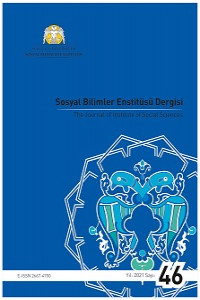Abstract
The purpose of this study is to analyze the discourse and the policies of the official religion, Islam, in Turkey about the pandemic. Understanding the attempt to explain and interpret the virus in the eyes of the Muslims, and the process followed by that discourse throughout the pandemic are the focus points of this study. There has been intense cooperation between religion and politics in Turkey in terms of the policies regarding the recent pandemic in the country; the official Turkish Islam has a great function in legalizing the decisions of the government by refering to religious sources and provide continuance of the indivuduals’ belonging with DİYANET. It is observed that “Islamic plague culture” and the previous experiences about similar disasters have been taken as references throughout the pandemic. In this respect, this study aims to define the pandemic through the eyes of the official Islam in Turkey, to locate the individual and define his/her elbow room, and to analyze the reorganized daily life and new dimensions of the reconstructed conscious based on new fatwa with a “qualitative descriptive” method.
References
- Abouzzohour, Y. (2020) COVID in the Maghreb: Responses and Impacts. In The COVID-19 Pandemic in the Middle East and North Africa (Pp: 51-54), Middle political Science. https://pomeps.org/wp-content/uploads/2020/04/POMEPS_Studies_39_Web.pdf
- Ashforth, B. E. & Fred A. M. (1989). Social Identity Theory and Organization, Academy Of Management Review, 14 (1). 20-39.
- Billig, M. (2002), Henri Tajfel's ‘Cognitive Aspects of Prejudice’ And The Psychology of Bigotry. British Journal of Social Psychology, 41: 171-188. https://doi.org/10.1348/014466602760060165
- Çıtırık, A., n. & Zengi̇n, Z. S. (2020). Küresel Salgın Zamanında Din Görevlileri Gözüyle Diyanet İşleri Başkanlığı’nın Yaygın Din Hizmeti ve Eğitimi . Yüzüncü Yıl Üniversitesi Sosyal Bilimler Enstitüsü Dergisi , Salgın Hastalıklar Özel Sayısı, 599-624 . Retrieved from https://dergipark.org.tr/tr/pub/yyusbed/issue/56115/772151
- Colorafi, K. J., & Evans, B. (2016). Qualitative Descriptive Methods in Health Science Research. HERD: Health Environments Research & Design Journal, 9(4), 16–25. https://doi.org/10.1177/1937586715614171
- Cornell, S. E. (2015). The Rise of Diyanet: the Politicization of Turkey’s Directorate of Religious Affairs. https://www.turkeyanalyst.org/publications/turkey-analyst-articles/item/463-the-rise-of-diyanet-the-politicization-of-turkey%E2%80%99s-directorate-of-religious-affairs.html
- Cunningham, A. (2008). Epidemics, Pandemics, and the Doomsday Scenario. Historically Speaking 9(7), 29-31.
- DIB, (2020a). Din İşleri Yüksek Kurulu’ndan Cuma Namazıyla Ilgili Açıklama. https://www.diyanet.gov.tr/tr-TR/Kurumsal/Detay/29391/din-isleri-yuksek-kurulundancuma-namaziyla-ilgili-aciklama
- DIB, (2020b). Diyanet İşleri Başkanı Erbaş, Koronavirüsle Ilgili Tedbirleri Açıkladı https://www.diyanet.gov.tr/tr-TR/Kurumsal/Detay/29392/diyanet-isleri-baskani-erbas-koronavirusle-ilgili-tedbirleri-acikladi
- DIB, (2020c) Diyanet İşleri Başkanlığı’ndan Cuma Namazı Ile Ilgili Açıklama https://www.diyanet.gov.tr/tr-TR/Kurumsal/Detay/29452/diyanet-isleri-baskanligindancuma-namazi-ile-ilgili-aciklama
- DIB, (2020d) Din İşleri Yüksek Kurulu’ndan Cuma Namazıyla Ilgili Açıklama https://www.diyanet.gov.tr/tr-TR/Kurumsal/Detay/29391/din-isleri-yuksek-kurulundan-cuma-namaziyla-ilgili-aciklama
- DIB, (2020e) Personelimiz Vefa Koordinasyon Grupları'nın Içerisinde Insanımıza Hizmet Ediyor https://www.diyanet.gov.tr/tr-TR/Kurumsal/Detay/29467/personelimiz-vefa-koordinasyon-gruplarinin-icerisinde-insanimiza-hizmet-ediyor
- DIB, (2020f) Diyanet İşleri Başkanı Erbaş'tan Cuma Mesajı https://www.diyanet.gov.tr/tr-TR/Content/PrintDetail/29416 El-Alaskani, H. (2012). Buluğu’l Meram: Ahkam Hadisler. Istanbul: Milat
- Freyer, H. (1964). Din Sosyolojisi. (Trans. T. Kalpsüz). Ankara: Ankara Üniversitesi Yayınları.
Abstract
Bu çalışma, Türkiye’de resmi dini söylemin, pandemiye yönelik politikalarını ve virüsü müminlerin gözünde anlamlandırma sürecini ve çabasını analiz etmektedir. Türkiye’de dinin ve siyasetin yoğun bir iş birliği içinde olduğu pandemi uygulamalarında Türk İslamı, cemaatin dağılmasını önlemek ve devlet bünyesinde alınan kararları dini zeminde meşrulaştırmak noktasında önemli bir işlev görmüştür. Bu süreçte ise önemli oranda “İslam veba kültürü”nün ve deneyimlerinin referans alındığı görülmektedir. Bu yönüyle çalışma, pandeminin Türkiye’de resmi İslam penceresinden tanımlanması, bireyin konumlandırılması ve hareket alanının belirlenmesi, fetvaların yayınlanması ile yeniden düzenlenen gündelik hayat ve inşa edilen bilincin yeni boyutlarını niteliksel betimsel bir yöntem ile ele almayı amaçlamaktadır.
Keywords
References
- Abouzzohour, Y. (2020) COVID in the Maghreb: Responses and Impacts. In The COVID-19 Pandemic in the Middle East and North Africa (Pp: 51-54), Middle political Science. https://pomeps.org/wp-content/uploads/2020/04/POMEPS_Studies_39_Web.pdf
- Ashforth, B. E. & Fred A. M. (1989). Social Identity Theory and Organization, Academy Of Management Review, 14 (1). 20-39.
- Billig, M. (2002), Henri Tajfel's ‘Cognitive Aspects of Prejudice’ And The Psychology of Bigotry. British Journal of Social Psychology, 41: 171-188. https://doi.org/10.1348/014466602760060165
- Çıtırık, A., n. & Zengi̇n, Z. S. (2020). Küresel Salgın Zamanında Din Görevlileri Gözüyle Diyanet İşleri Başkanlığı’nın Yaygın Din Hizmeti ve Eğitimi . Yüzüncü Yıl Üniversitesi Sosyal Bilimler Enstitüsü Dergisi , Salgın Hastalıklar Özel Sayısı, 599-624 . Retrieved from https://dergipark.org.tr/tr/pub/yyusbed/issue/56115/772151
- Colorafi, K. J., & Evans, B. (2016). Qualitative Descriptive Methods in Health Science Research. HERD: Health Environments Research & Design Journal, 9(4), 16–25. https://doi.org/10.1177/1937586715614171
- Cornell, S. E. (2015). The Rise of Diyanet: the Politicization of Turkey’s Directorate of Religious Affairs. https://www.turkeyanalyst.org/publications/turkey-analyst-articles/item/463-the-rise-of-diyanet-the-politicization-of-turkey%E2%80%99s-directorate-of-religious-affairs.html
- Cunningham, A. (2008). Epidemics, Pandemics, and the Doomsday Scenario. Historically Speaking 9(7), 29-31.
- DIB, (2020a). Din İşleri Yüksek Kurulu’ndan Cuma Namazıyla Ilgili Açıklama. https://www.diyanet.gov.tr/tr-TR/Kurumsal/Detay/29391/din-isleri-yuksek-kurulundancuma-namaziyla-ilgili-aciklama
- DIB, (2020b). Diyanet İşleri Başkanı Erbaş, Koronavirüsle Ilgili Tedbirleri Açıkladı https://www.diyanet.gov.tr/tr-TR/Kurumsal/Detay/29392/diyanet-isleri-baskani-erbas-koronavirusle-ilgili-tedbirleri-acikladi
- DIB, (2020c) Diyanet İşleri Başkanlığı’ndan Cuma Namazı Ile Ilgili Açıklama https://www.diyanet.gov.tr/tr-TR/Kurumsal/Detay/29452/diyanet-isleri-baskanligindancuma-namazi-ile-ilgili-aciklama
- DIB, (2020d) Din İşleri Yüksek Kurulu’ndan Cuma Namazıyla Ilgili Açıklama https://www.diyanet.gov.tr/tr-TR/Kurumsal/Detay/29391/din-isleri-yuksek-kurulundan-cuma-namaziyla-ilgili-aciklama
- DIB, (2020e) Personelimiz Vefa Koordinasyon Grupları'nın Içerisinde Insanımıza Hizmet Ediyor https://www.diyanet.gov.tr/tr-TR/Kurumsal/Detay/29467/personelimiz-vefa-koordinasyon-gruplarinin-icerisinde-insanimiza-hizmet-ediyor
- DIB, (2020f) Diyanet İşleri Başkanı Erbaş'tan Cuma Mesajı https://www.diyanet.gov.tr/tr-TR/Content/PrintDetail/29416 El-Alaskani, H. (2012). Buluğu’l Meram: Ahkam Hadisler. Istanbul: Milat
- Freyer, H. (1964). Din Sosyolojisi. (Trans. T. Kalpsüz). Ankara: Ankara Üniversitesi Yayınları.
Details
| Primary Language | English |
|---|---|
| Journal Section | Research Articles |
| Authors | |
| Publication Date | October 20, 2021 |
| Submission Date | April 19, 2021 |
| Published in Issue | Year 2021 Issue: 46 |
This work is licensed under a Creative Commons Attribution-NonCommercial 4.0 International License


